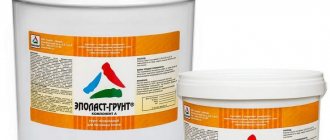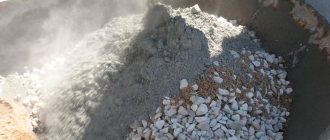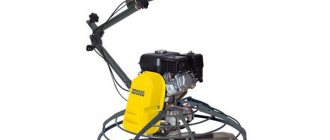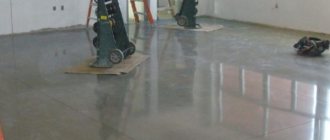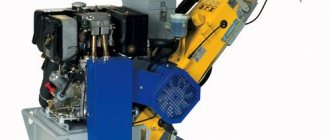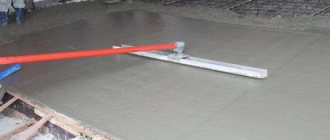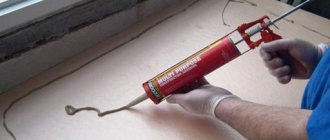What is polyurethane
Polyurethane is a polymer that is produced during the refining of crude oil. To obtain the desired final product, catalyzing, stabilizing and foaming substances, as well as dyes, react.
Various combinations of these substances allow the production of polyurethane:
- in solid form for use as a structural material in many industries;
- in liquid form, serving as a basis for coloring compositions, glue and sealants;
- elastic, in this form the polymer successfully replaces rubber.
Paint for concrete - characteristics of the coloring composition
Although concrete is considered a durable material, it can gradually deteriorate under the influence of negative environmental factors. Painting concrete surfaces helps prevent destruction. Concrete paint consists of polyester resins, hardener, various fillers and dyes.
The coatings it forms are characterized by:
- increased moisture resistance;
- chemical resistance;
- high covering ability;
- excellent adhesion to concrete;
- high wear resistance;
- increased heat resistance;
- resistance to weather conditions;
- resistance to mechanical loads (film strength upon impact is at least 50 cm).
Concrete paints are easy and simple to apply and are versatile in application.
Polyurethane enamel for concrete
Polyurethane enamels Elakor-PU and Enamel-60 are colored, one-component, moisture-curing. After hardening, they form a durable polymer with high impact strength and high wear resistance.
Elakor-PU Enamel-60 polyurethane enamel - price
label
Packing
All polyurethane enamels Elakor-PU All paints for concrete Elakor-PU
Compared to “regular” Enamel “Elakor-PU” Enamel-60 has an increased dry residue. Due to this, it forms a thicker film in one layer of application. The thickness of 2 layers of Enamel-60 is equal to 3 layers of “regular” Elakor-PU Enamel.
Reference: Elakor-PU enamels, according to the classification of the Chemical Encyclopedia, belong to “enamel paints”, so they can be called both paint and enamel.
Chemical resistance. Constant contact with water; solutions of neutral, acidic and alkaline electrolytes; mineral, synthetic, organic oils; aromatic solvents, gasoline, diesel fuel, etc.
Polyurethane enamel for concrete - area of application.
- Installation of polyurethane floors, protection from mechanical and chemical effects of floors, walls, ceilings, products, structures, etc.
- Installation of colored paint coatings; decorative coatings with chips, flocks, glitter.
- Installation of quartz-filled coatings, anti-slip coatings, antistatic coatings.
- Puttying concrete.
Polyurethane enamel is intended for use indoors and “under cover”.
- The polyurethane coating changes color (turns yellow), but the protective properties do not change.
- It is necessary to waterproof the concrete base from groundwater.
For surfaces (cleaned and primed with Elakor-PU primers).
- Mineral capillary-porous surfaces: concrete, sand-cement screed; mosaic concrete, breccia, paving and mosaic tiles; magnesium concrete; brick, asbestos cement (slate), etc.
- Wooden surfaces: wood, parquet, plywood, fiberboard, chipboard, etc.
Objects of application of polyurethane enamel for concrete.
- Production workshops, including food and pharmaceutical industries.
- Warehouses, warehouse complexes, freezers, refrigerators.
- Garages, parking lots, parking lots, car washes, car services.
- Shopping and shopping and entertainment complexes, exhibition and sports halls;
- Housing and civil facilities.
- Agricultural facilities: cowsheds, pigsties, poultry farms, feed storage facilities, etc.
- Swimming pools, settling tanks, treatment facilities, reservoirs.
Elakor-PU is approved for use (additionally certified).
- In housing construction, in children's and medical institutions.
- At enterprises of the food and pharmaceutical industries.
- At agricultural sites.
- At Rosatom enterprises (compliance with GOST R 51102-97).
Flammability group - G1, flammability group - B1.
Properties.
- Deep impregnation of concrete and concrete hardening (up to M600 and above).
- Complete sealing and dust removal of concrete.
- High wear resistance and impact strength.
- High chemical resistance.
- Operating temperature from -60 °C to +120 °C.
- Good decorative properties and ease of cleaning.
Advantages.
- Polyurethane enamel Elakor-PU can be applied at temperatures from minus 30 °C.
- Short drying time of the layer (3-6 hours) – minimal work time.
- After application: after 1 day - pedestrian load, after 3 days - full load.
- One-component polyurethane enamel provides simple application technology.
Brief instructions for the use of polyurethane enamel for concrete.
Primary requirements. The presence of waterproofing of the base (no capillary rise of water) from below. Residual moisture content of the base – no more than 5%. No irremovable oily areas.
Preparing the base. Sand the concrete surface with a mosaic grinder to remove cement laitance, dirt, old paint, etc. Remove dust with an industrial vacuum cleaner and prime with Elakor-PU primers.
Application. Before use, stir the polyurethane enamel thoroughly. Apply with a medium-wool (nap 12-16 mm) polyamide roller in 2-4 layers (depending on the task), layer-by-layer drying 4-8 hours, consumption per layer 110-140 g/m².
The main characteristics of polyurethane enamel for concrete Elakor-PU: tensile strength of at least 60 MPa; relative elongation at break of at least 20%;
Types of protective polyurethane compounds for concrete surfaces
Since the one-component composition does not have a hardener, the polymerization process of the coating occurs by interaction with air. Its thin-layer nature facilitates rapid hardening.
Two-component mixtures consist of a pigmented component and a hardener. The convenience of using these mixtures lies in the longer setting period of the coating.
Primer
Just like paints, polyurethane primers are:
- Single-component. They are used for indoor work. Thanks to its fluid structure, the composition penetrates into the concrete base, leveling its surface and increasing adhesion to the finishing coating.
- Two-component. These primers are stronger, but not as flowable due to the hardener content. They are used for outdoor work or priming concrete floors in high-traffic areas.
Mastics
Protective compositions for concrete surfaces also include polyurethane mastics. They are designed for waterproofing. As a result of applying the composition, a complete coating is formed in the form of a durable film, under which the expansion joint is also hidden. To polymerize the coating, interaction with air is sufficient. Polyurethane mastic is applied in two ways. By hand with a brush or roller. Using an airless spray device. It is advisable to use this type of mastic for small-scale work.
Paints
Polyurethane-based paints are another type of protective coating for concrete surfaces. They consist of one or two components. Polyurethane two-component paint for concrete, in addition to polyester resins, contains hardeners, fillers and dyes. The molecules of the components bind together to form a waterproof protective film, characterized by increased resistance to acids.
A similar suspension is used to protect concrete floors indoors, as well as for painting various structures. Some manufacturers produce polyurethane paints for concrete that contain a solvent. Such coloring compositions are single-component. Water-dispersion compositions containing ordinary water instead of solvents are also considered one-component.
Self-leveling floors
High-quality finishing flooring is made using self-leveling flooring. It is distinguished by its solidity and lack of joints.
Often the self-leveling floor itself plays a decorative role. The material may consist of polyurethane or epoxy resins, mineral fillers and decorative additives. All these components make it possible to make the coating durable and resistant to negative influences, while ensuring a beautiful appearance of the floor.
Features of two-component paints
During manufacturing, two-component polyurethane paint for concrete floors is packaged in two containers: one is filled with a polyurethane base, the other with a hardener. In addition to polyurethane, two-component paint compositions are made on the basis of acrylic and epoxy resin. Acrylic paint has a bright tonality.
For painting concrete indoors, wear-resistant acrylic paint is most often used. Compared to one-component compositions, two-component polyurethane paints for concrete are of higher quality, so applying one layer is enough to create a wear-resistant coating.
Advantages
- It is no coincidence that polyurethane paints and varnishes are used for painting production areas that are constantly subjected to heavy loads;
- increased adhesive strength, in particular to concrete;
- safety of working with paintwork materials and operation of painted surfaces, thanks to the chemical stability of polyurethane and the use of odorless solvents;
- UV resistance;
- chemical resistance, so polyurethane coatings can be used in aggressive environments.
Application
Due to its high performance characteristics, two-component polyurethane paint for concrete for exterior use has found wide application in repair and construction work.
Two-component polyurethane paint
This mixture combines a composition of a special hardener and enamel. The composition includes two components that must be mixed according to the instructions provided by the manufacturer.
When it is necessary to paint a large area, it should be taken into account that the mixed two-component polyurethane enamel hardens quite quickly. Compared to one-component enamels, such a mixture has significantly higher wear resistance and is less susceptible to various atmospheric influences.
It must be taken into account that the maximum operating temperature limit is no more than +100˚C. At facilities with elevated temperature conditions, a special fire-fighting composition is used to reliably protect metal structures.
Surface preparation and application
Today the range of polymer coatings is quite wide. Manufacturers offer different types of polyurethane paints for concrete. They differ not only in composition, but also in characteristics. For example, the thin-layer coating that the enamel polymer forms is characterized by increased wear resistance. Consequently, the requirements for painted surfaces and the conditions for applying paints and varnishes may differ. Therefore, you must follow the instructions that are on each can. But it’s better to find out what needs to be prepared for painting even before choosing enamel for the floors.
Requirements for surfaces
- the surface must be cleaned of dirt, splashes, dust, efflorescence, grease stains and solution drips;
- its humidity should not exceed 4%;
- old paintwork materials with poor adhesion must be removed;
- Impregnations and sealants must be applied to waterproof small cracks;
- Apply appropriate primer (polyurethane or acrylic primer).
Features of application and care
Before applying the paint to the base, it must be properly prepared: stir, if necessary, remove the film and filter. To bring the paint into working condition, you need to tightly close the jar with a lid and turn it upside down. Shake and turn back over. The temperature at the painting site should not be lower than +15°C and not higher than +30°C. Air humidity at a temperature of 20 degrees should not exceed 85%.
The paint composition can be applied in one or several layers. To obtain an even and smooth finish, polyurethane concrete floor paint is distributed evenly using a roller or metal spatula with additional rolling with a roller. After laying the first layer, you must immediately begin applying the second. Industrial concrete floors with a polyurethane surface do not require special maintenance. But you should still avoid spills of water and concentrated strong acids that remain on the floor for a long time in the form of puddles.
LKMFLOT
Code: 100990054
Category:
Paints and Enamels
Brand:
Elakor
Packing:
5, 10, 22, 30, 50
Packing:
1
Polyurethane paint for concrete Elakor
DESCRIPTION: Polyurethane paint for concrete Elakor-PU is a colored one-component moisture-curing polyurethane enamel. Can be applied at subzero temperatures (from minus 30°C). After polymerization, it forms a hard-elastic polymer with high impact strength, high strength and wear resistance. Reference. Elakor-PU Enamel-60, according to the classification of the Chemical Encyclopedia, belongs to “enamel paints”, so it can be called both paint and enamel.
FIELD OF APPLICATION: Protection against mechanical and chemical effects of concrete floors, walls, ceilings, products, structures, etc. • Installation of colored paint coatings – polyurethane floors. • Installation of decorative polyurethane floors with chips, flocks, glitter. • Construction of quartz-filled coatings (coatings with sand), anti-slip coatings, antistatic coatings. For indoor use, “under a canopy”, outdoor use – limited. The use of polyurethane enamel outdoors is limited by the following factors: • there is a change in color (turns yellow) or a shift in shade, the protective properties do not change, • the presence of concrete waterproofing from groundwater is required. For surfaces (cleaned and primed with Elakor-PU soils): • Mineral capillary-porous surfaces: concrete, sand-cement screed, mosaic concrete, breccia, paving and mosaic tiles, magnesium concrete, brick, asbestos cement (slate), etc. • Wooden surfaces: wood, parquet, plywood, fiberboard, chipboard, etc.
OBJECTS OF APPLICATION: • Warehouses (including aggressive substances), hangars, refrigerators, freezers. • Production workshops of almost any industry. • Garages, parking lots, car washes, car services, repair shops. • Trade, exhibition, sports halls, residential, public, administrative buildings. • Agricultural facilities: poultry farms, incubators, cowsheds, pigsties, etc. • Reservoirs, technical pools, settling tanks, treatment facilities. Elakor polyurethane floors are approved for use (additionally certified): • In housing construction, in children's and medical institutions. • At food and pharmaceutical industries. • At agricultural sites. • At Rosatom enterprises (compliance with GOST R 51102-97).
TECHNICAL CHARACTERISTICS: Fire safety characteristics of Elakor-PU polyurethane floors. Flammability group - G1, flammability group - B1. Compared to “regular” Enamel “Elakor-PU” Enamel-60 has an increased dry residue. Due to this, it forms a thicker film in one layer of application. The thickness of 2 layers of Enamel-60 is equal to 3 layers of “regular” Elakor-PU Enamel. Chemical resistance of polyurethane concrete paint. Constant contact with water, solutions of neutral, acidic and alkaline electrolytes, mineral, synthetic, organic oils, gasoline, diesel fuel, etc. The tensile strength of the film is not less than 60 MPa, the relative elongation at break is not less than 20%.
PROPERTIES OF POLYURETHANE FLOORS: Properties of polyurethane floors based on polyurethane paint for concrete Elakor-PU Enamel-60. • Deep impregnation of concrete and concrete hardening (up to M600 and above). • Complete sealing and dust removal of concrete. • High wear resistance and impact strength. • High chemical resistance. • Operating temperature from -60 °C to +120 °C. • Good decorative properties and ease of cleaning.
ADVANTAGES: • Polyurethane paint for concrete Elakor-PU can be applied at temperatures from minus 30°C. • It is possible to strengthen concrete bases even of grades M100 and less. • Short layer-by-layer drying (3-6 hours) – short work time. • After application: after 1 day - you can walk, after 3 days - full mechanical load. • Polyurethane paint for concrete is a one-component material - therefore, simple technology, inexpensive equipment.
DIRECTIONS FOR USE: Basic requirements. The presence of waterproofing of the base (no capillary rise of water) from below. Residual moisture content of the base – no more than 5%. No irremovable oily areas. Preparatory work. Sand the concrete with a mosaic grinder to remove cement laitance, dirt, etc. Remove dust with an industrial vacuum cleaner. Prime with Elakor-PU primers. Application. Stir polyurethane concrete paint thoroughly before use. Apply with a medium-wool (nap 12-16 mm) polyamide roller in 2-4 layers (depending on the task), layer-by-layer drying 4-8 hours, consumption per layer 140-170 g/m?.
STORAGE LIFE: Guaranteed shelf life in manufacturer's containers at temperatures from –40°C to +30°C is 6 months.
PACKING: plastic – 5, 10, 30 kg, metal – 5, 10, 20, 50 kg.
Polyurethane paint for concrete: the use of a substance with unlimited possibilities
Polyurethane has a wide range of useful properties, and structures made of durable building materials coated with it acquire amazing wear-resistant qualities. This article contains information about what polyurethane paint for concrete is, what types there are and what it is intended for. As well as general information about the features of its main component.
What is polyurethane?
Polyurethane is a synthetic material based on components obtained from crude oil and belongs to the group of elastomers.
There are the following types:
- Liquid or cast. It is used as a basis for the manufacture of paints, sealants, adhesives, or used for molding products from it.
- Elastic or elastic . A material with these properties replaces rubber and caoutchouc, surpassing them in service life and all other characteristics. Polyurethane can deform plastically under load, and after it is removed, it can be completely restored. It is used to produce threads, fibers, molds for casting concrete products and much more.
- Solid . Such a material can already be compared with structural metal, which has increased elastic properties and is not subject to corrosion. Separate mechanical parts, gear shafts, and bushings can be made from it, which will last much longer than their metal counterparts.
The scope of application of this material is the most extensive - it is a substance with literally unlimited possibilities. Clothes are made from it, used as insulation, covering for cars and trucks, and also used in the most severe operating conditions in aggressive environments and high mechanical stress to protect basic structures. For example, such armor for the floor can be made using polyurethane paints for concrete.
Note: the versatility of the technical characteristics and properties of polyurethane products is achieved at the production stage - by adding various components to the composition, according to developed recipes.
Types of protective polyurethane compounds for concrete surfaces
There are one- and two-component mixtures. In the first version there is no hardener; its role is played by natural air humidity.
These are mainly thin-layer coatings for universal use. In the second case, curing occurs due to the hardener present directly in the composition. With their help, self-leveling floors are often installed. Let's look at the types of polyurethane coatings for concrete using specific examples.
Primer
Both independent mixtures and base coatings diluted up to 15% can act as a primer.
Important! During application, and during the entire curing period, splashes of water or precipitation are not allowed on the surface.
Universum Primer P 03 is a one-component polyurethane composition, the curing of which occurs under natural air humidity. Has high adhesion to mineral substrates. It is used under thin-layer coatings and self-leveling floors to remove dust, harden and impart water-resistant properties to the surface. Consumption for 2 layers is 0.7 kg/m2.
Please note: not all coatings can be thinned and used for priming; the instructions included with the relevant product inform you about this.
Mastics
Mastics serve to waterproof the surface. Some compositions can be tinted and used as a finishing decorative polyurethane concrete floor paint, which has not only hydrophobic, but also wear-resistant properties.
AlChimica "Hyperdesmo" is a one-component universal waterproofing mastic, ready for application, similar in appearance and consistency to paint. It is used under cement screed or parquet, under tiles in bathrooms, as a final hydrophobic-decorative paint for swimming pools and fountains. It can also be used to cover drinking water tanks. Consumption for 2 layers – 1.5 kg/m2.
Types of polyurethane dyes for concrete
Polyurethane is a material with a wide range of useful consumer properties. Polyurethane paint for concrete gives the substrates on which it is applied high wear resistance. Most often it is used to cover floors in public and industrial premises.
Polyurethane paint for concrete
As a rule, polyurethane enamel is sold only in the form of a two-component mixture. Enamel can be used in closed objects, as well as in open areas. Such paints have excellent indicators of efficiency and environmental friendliness, while they are able to withstand any external influences. After painting, the surface turns out to be perfectly smooth and aesthetically very beautiful.
When working with polyurethane paint for concrete, several important factors must be taken into account. The air temperature during the application of paint and varnish should be at least +5 ˚C, and humidity no more than 75%.
Since the mixture is two-component, it is necessary to mix the components before painting. First of all, you should thoroughly mix the first component, after which the second is added to it.
The main disadvantage of this coating is its long drying time. Depending on the chosen manufacturer, as well as the composition, the period for complete drying of the paint can range from three days to two weeks.
Full resistance to mechanical stress is achieved within a week, and to chemical stress after 14 days. It should be taken into account that before applying the composition, the surface must be treated with a polyurethane primer. It is very easy to apply and ensures perfect adhesion of the paint to the surface.
What is polyurethane
Polyurethane belongs to a group of polymers obtained from the refining of crude oil. In the process of its production, catalyzing and stabilizing agents, as well as foaming agents and dyes are used.
The use of various combinations of these substances allows us to obtain a final product with different characteristics:
- solid polyurethane is in demand as a structural material and is used in industrial production;
- liquid compositions are used as a basis for paints, varnishes, adhesives and sealing compounds;
- elastic polyurethane can replace rubber.
Types of protective polyurethane compounds for concrete surfaces
Concrete is one of the most durable building materials, but negative environmental factors (moisture, mechanical stress, etc.) lead to its gradual destruction. Applying a polyurethane composition to such substrates prevents this process. Depending on the purpose, one- or two-component mixtures are used.
Polyurethane-based paints and varnishes are intended mainly for use in professional or semi-professional areas. With their help, coatings are created that are resistant to mechanical and chemical influences. In the domestic sphere, such coatings will protect the base of a building or premises with high humidity (swimming pools, bathrooms, etc.) from moisture and mold. To solve a particular problem, various types of polyurethane compounds are used.
Primer
For pre-treatment of bases, either independent mixtures or base coatings pre-diluted to 15% are used.
During the application of primers and their curing, the surface must be protected from water or precipitation.
The compositions are distinguished by good adhesion to concrete bases, even when applied in a thin layer, they give them additional strength and water resistance.
Mastics
Polyurethane mastics are used for waterproofing surfaces. Some of them can be tinted and applied as a final floor paint to increase its durability. Mastic is applied under cement screed, tiles or mosaics in bathrooms, saunas and swimming pools, fountains. It can also coat the inside of drinking water tanks.
Paints
Polyurethane paint for concrete is a thin-layer coating, the thickness of which does not exceed 1 mm. Such compositions cannot be used to level bases - they only give the latter additional wear-resistant properties and protect them from external influences, mold and mildew. At the same time, polyurethane mixtures (both one- and two-component) fade or change shade when exposed to ultraviolet rays.
Self-leveling floors
Self-leveling floors are called medium- or thick-layer self-leveling coatings. Its thickness is 2-8 mm and allows you to mask cracks not exceeding 2 mm in width, unevenness and small differences in floor heights.
Self-leveling floors are highly durable and durable. They are designed not only for indoors, but also for outdoor areas. Industrial polyurethane floors do not require special care. Their surface is resistant to mechanical stress, chemicals and abrasives.
Household self-leveling floors require more delicate care. It is not recommended to wash them with concentrated products containing acids, which can damage the polyurethane coating.
Review of polymer paints for concrete floors
The obvious advantages of polymer paints include:
- safety for people and nature;
- long service life and wear resistance;
- relatively low cost;
- wide choice of colors;
- ease of application to the concrete surface.
Concrete floor after applying polymer paint
What paints are used to coat concrete?
Practice shows that the optimal solution is to use the following paints:
- polyurethane;
- acrylic;
- epoxy.
All types of coatings listed can be used for application to floors and other structures made of concrete. The basic requirements for concrete paints are given below:
- resistance to moisture;
- immunity to atmospheric and weather phenomena;
- removing dust from the concrete surface;
- resistance to fading from ultraviolet radiation.
In addition, paints for concrete should be resistant to low temperatures. All types of paints or their modifications listed above meet all the above requirements.
Polyurethane coatings
The main task of any coating, including polyurethane, is to create a coating that successfully resists mechanical stress, in particular wear. They are practically immune to the effects of chemicals.
This type of paint is used in production facilities, sales areas, and logistics centers.
Epoxy resin paint
This paint, unlike other polymer materials, is reliable and durable. This ensures its long service life. Epoxy paints can easily withstand impact. It is advisable to use it in rooms with high traffic and people traffic.
In addition, paint based on epoxy resin does not fade, which makes it suitable for outdoor use. Typically, epoxy paint consists of two components that must be mixed thoroughly before use. This type of paint can be used on the surface of concrete that has not reached its design strength.
Epoxy paint with the addition of color will allow you to create a floor of any shade according to the RAL scale.
Acrylic paint
This paint is produced on the basis of acrylic resin in the form of a water-based composition. Acrylic paint perfectly protects concrete from moisture.
This happens due to the formation of a film that closes pores, small cracks, in a word, all places where moisture can penetrate inside the concrete structure. This property has led to its use in garages, car washes, etc.
It dries relatively quickly. The floor can be used within 12 - 14 hours after application.
Concrete surface painting technology
Before using polymer paints on concrete, you should prepare the surface - level, fill cracks and potholes, and to improve adhesion, you need to cover the concrete with a layer of primer.
The methods of applying paint to a concrete surface are essentially the same. Moreover, the same tools are used to apply paint. The paint can be applied with a brush of different widths and hair lengths or with a roller. The most productive way is to use a spray gun. The only exceptions are epoxy paints, as they have a quick setting property and can damage the spray gun.
Using a spray gun can significantly speed up the work of painting the surface, but you still need to have a brush on hand. It may be needed for applying paint to hard-to-reach places. In addition, one layer applied using mechanical means is equivalent to several layers of paint applied with a brush or roller.
Concrete floor being painted with a roller
There are minor differences in the preparation of the paint itself, for example, epoxy must first be mixed, it consists of two components and it must be used as quickly as possible, otherwise it will harden within a few hours.
Preparing the surface of a concrete structure
In addition to the type of paint, the quality of the coating of a concrete structure directly depends on the quality of work associated with preparing the concrete surface.
This work is carried out in several steps. After the concrete floor has been poured and has reached its design strength, you can begin preparing it for painting. First, you need to remove any debris that has accumulated on the floor surface during drying.
Concrete has the disadvantage of becoming dusty over time. To eliminate this phenomenon, you can use either special penetrating impregnations or a primer composition.
Their use will ensure the closure of pores and minor defects on the surface of the structure, that is, exactly those places where cement dust forms and accumulates.
If, during a preliminary inspection of a concrete structure, larger defects are discovered, for example, bulges or depressions, then measures must be taken to eliminate them. To eliminate depressions, you can use putty materials, but you must remember that the place where the putty is applied will need to be sanded.
After the floor is leveled and all minor surface defects have been eliminated, you can begin to apply a layer of soil mixture.
The main purpose of this material is to protect concrete from moisture, which, after penetrating into the structure, causes corrosion phenomena that begin to destroy steel reinforcement and the concrete itself.
In addition, the use of a primer increases the adhesion of paint to the concrete surface. Applying primer is the last operation to prepare a concrete structure. Once the primer has dried, painting can begin.
Concrete paint manufacturers
The production of paints and varnishes is a profitable business that is engaged in by many enterprises both in our country and abroad. Here is a short overview of manufacturers of polymer paints for concrete.
Krasko company. It has been operating in the market of paints and varnishes since 1999 and during this time it has accumulated sufficient experience in the production of paints and other materials used in production, construction, etc.
One of the company's activities is the production of paints, penetrating impregnations and primer compositions for treating the surface of concrete structures. The company has developed and mastered the production of paint and varnish complexes designed for treating concrete in various premises.
The company can order a concrete protection system for industrial buildings that house production facilities with high humidity, such as fish processing workshops.
This complex includes:
- impregnation "Protexil";
- primer "PS-Grunt";
- enamel "Polymerstone-1"
Products from the Streamline chemical company are distinguished by their high quality. It offers the consumer epoxy enamel EP-2346.
In addition to this enamel, the consumer is offered paint PU-2357, and some others made on the basis of polyurethane. Moreover, they are produced as one- and two-component. The products of Elakor also deserve interest. Founded back in 1996, it has firmly taken its place among the leaders in the production of paints for concrete floors.
This company produces paints, impregnations and other materials necessary for working with concrete. A distinctive feature of this enterprise is that you can not only buy the necessary materials, but also order the entire cycle of work related to floor installation. From manufacturing to painting. Another equally well-known domestic manufacturer of concrete paints is the Sibton company. The product range includes a full range of materials for protecting and painting concrete surfaces.
The popularity of concrete paints has created a situation where counterfeit products can be purchased on the market. Therefore, before purchasing it in a store or market, you must request quality certificates from the seller.
Source: https://nalivnye-3d-poly.com/materialy/obzor-polimernyh-krasok-dlya-betonnyh-polov
Popular brands and manufacturers
A major manufacturer of polyurethane foam compositions is. It offers glossy two-component polyurethane enamel “Polymerdecor 2K ECO”, which does not contain organic solvents. Its purpose is to create thin-layer polymer coatings. The paint is suitable for rooms with high mechanical loads; it is resistant to aggressive environments and abrasion.
Polyurethane floor enamel "Poliplast-85" is recommended to be applied to floors in industrial premises. The composition is suitable not only for concrete bases, but also for metal. The coating obtained using polyurethane enamel is resistant to mechanical stress, does not react with acids and alkalis, gasoline, and is highly resistant to mechanical wear. Initially, primer is applied to the surface, and enamel for concrete floors is laid on top of it.
The two-component composition "Dempopol-600" is a medium-layer coating based on polyurethane. Its task is to protect the concrete floor from shock, vibration and other mechanical influences. This paint and varnish product is a viscous and elastic polyurethane enamel that is odorless. After hardening, it absorbs impact and other deformations, then returning to its original shape. The Dempopola-600 composition is intended for treating floors in industrial workshops, car washes and parking lots, offices, exhibition halls, and oil refineries.
Thin-layer coatings for concrete floors.
They are used to prevent dust and protect concrete and cement-polymer floors from exposure to aggressive environments, as well as to make the floor decorative. Thin-layer systems are inexpensive and quite common within their field of application. The thickness of such coatings is small (up to 0.5 mm), so abrasion and “scratching” are inevitable during operation. Therefore, either the mechanical loads on the floors should be small (pedestrian areas or the movement of light cargo trolleys on pneumatic wheels), or the impact of aggressive environments should be short-term. Otherwise, reaching the base through scratches and abrasions, aggressive environments will cause its destruction. You should not count on a long repair-free service life of thin-layer systems - it is short, but the low price allows for their systematic renewal. Weather-resistant, wear-resistant coating for finishing and marking sports surfaces. It has increased wear resistance and meets a number of important requirements: temperature changes, sun, light, cold, high or low humidity, and resistance to solar radiation.
